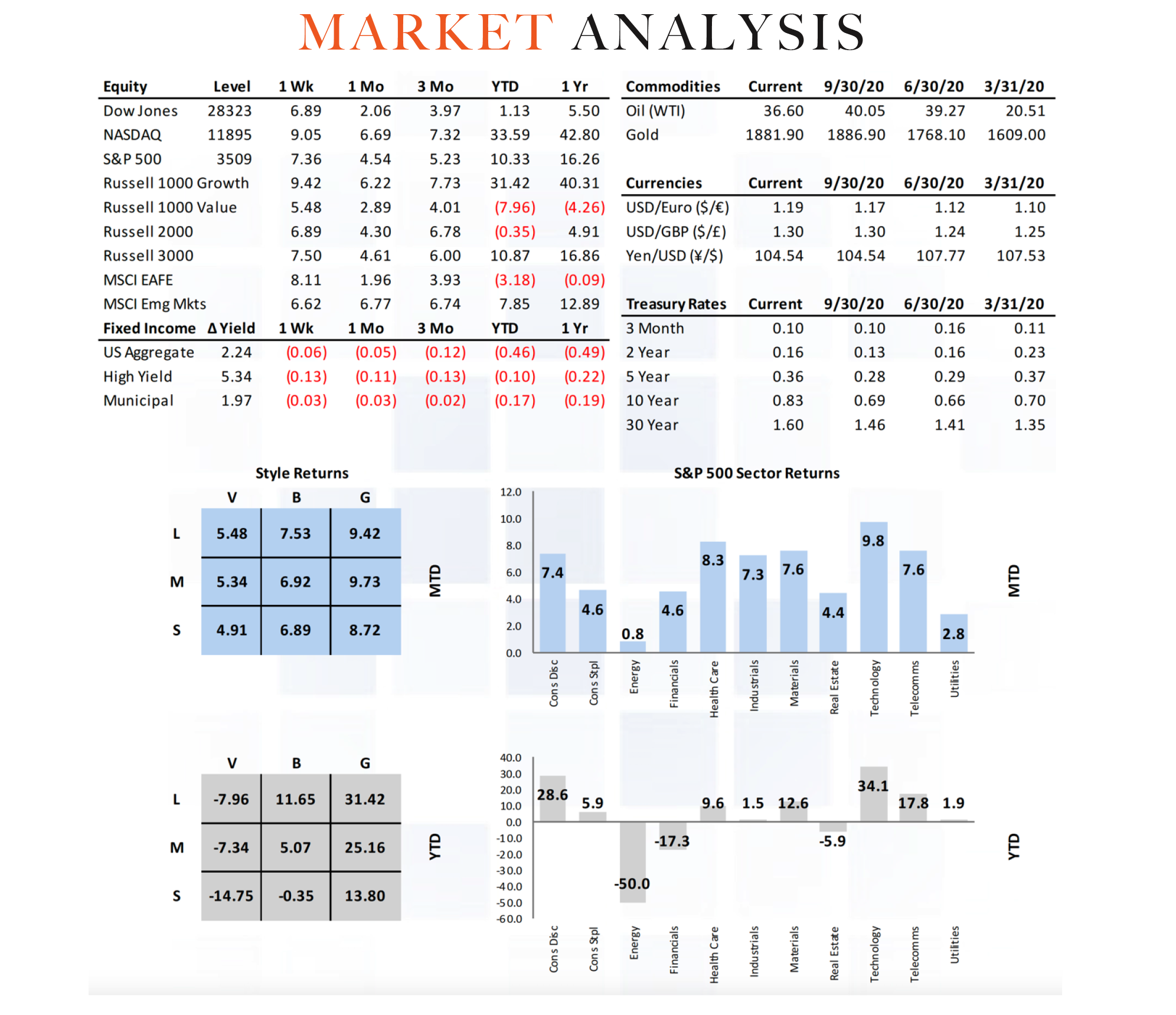Markets surge in wake of presidential election outcome
Equity markets surged (6%-7%) to their best showing since April last week as election outcomes began to materialize.
With Senate outcomes still in limbo, markets cheered what looks like a gridlock scenario with Vice President Joe Biden taking the White House and market friendly policy compromises thanks to mixed Congressional power. Healthcare and technology led the way while energy and real estate lagged. Commodities benefited from a risk on rally in oil and long treasury bonds surged initially on contested election news bits but stayed suppressed due to a reduced likelihood of a sizable CoVid relief package.
Market Anecdotes
• After the worst pre-election stock market week on record, the S&P 500 delivered its best week since April as the election outcome and policy handicapping began to clear up.
• Tax hikes, infrastructure spending, green new deal, healthcare reform, regulation, and tech sector vilification have taken a back seat under a divided government scenario. The end of the trade wars, more modest CoVid fiscal relief, and eliminated tariffs are also likely.
• Emerging markets have benefited materially from the GOP Senate / Biden White House driven by currency implications of a weak USD due to lower interest rates (growth), lower Treasury issuance (deficit spending), and more stable foreign and trade policies.
• With 89% reported, FactSet noted record beat rates of 86% and margins of 19.5% for a blended Year over Year earnings decline of -7.5%. Revenue is coming in at -2.1% with record beats (79%) and margin (2.6%) of beats.
• The October FOMC meeting happened last week. As expected, no change in policy and they stand ready to enact fresh QE along with other measures if deemed necessary.
• The Bank of England surprised the markets by announcing £150 billion of quantitative easing. This was £50 billion more than expected.
• BCA pointed out an important sub-component of last week’s GDP report is that the contribution from state & local government spending turned negative as it did in 2009/2010 where it remained a drag until 2014 – a significant contributor to subpar GFC recovery growth.
• CoVid is becoming more prevalent in the U.S. as the “third surge” does not seem yet to be slowing down.
• European and Canadian approaches to health policy/lockdowns are being closely watched as proxies for full spring 2020 style versus partial targeted approach.
• The September Black Knight Mortgage Monitor showed a slight improvement in delinquencies and record originations.
Economic Release Highlights
• The October jobs report was strong with 638,000 new jobs taking the unemployment rate down to 6.9% (7.6% expected) and non-farm, private, and manufacturing payrolls all topping expectations.
• October’s U.S. manufacturing PMI improved slightly to 53.4 while the ISM manufacturing surged and crushed expectations (59.3 v 55.7). The Composite improved from 54.3 to 56.9 in October.
• The global manufacturing PMI was 53.3, an improvement from 52.1 prior reading. The European Union registered a healthy 54.8, China 53.6, India 58.6 and Germany 58.2.
• October’s ISM services index softened slightly to 56.6 from last month’s 57.8 reading.
W E E K E N D I N G 11 / 06 / 2 0
INSIGHT
MARKET ANALYSIS






